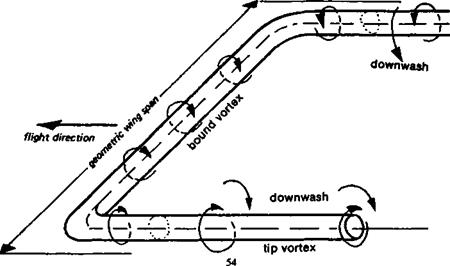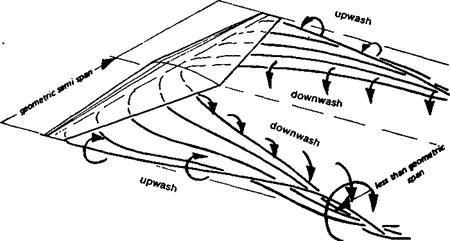DOWNWASH
If the wing and its ‘rolled up’ vortex system is viewed from the rear, as indicated in Figure 5.4, the effect of the rotation of the vortices is to create downwash behind the wing and upwash on the outer sides. This downwash is not the same as the downwash, associated with the upwash and pressure distribution, of Fig. 2.2. That was part of the lift or bound vortex mechanism. The tip vortex downwash produces no useful lift, but it does change the general direction of flow over the wing as a whole. The streamlined flow pattern of Figure 2.2 must be considered as superimposed upon the vortex-induced downwash. The wing is at some geometric angle of attack to the undisturbed airflow remote from the wing, but near the wing the downwash effect of the trailing vortices distorts the whole flow
|
|
|

|
Fig. 5.3 The vortex sheet behind a real wing
|
system in proportion to the strength of the vortices (Fig. 5.5). The aerodynamic angle of attack is reduced by die vortex downwash.
The lift force required for flight must be directed at right angles to the flight path, but the wing reaction force (neglecting profile and skin drag) is at right angles to the local airflow as changed by the downwash. The resolution of forces in Figure 5.6 shows the origin of vortex-induced drag as a component of the total reaction, directed aft The greater the geometric angle of attack, the higher the Cl at angles below stall. The higher the Cl for a given wing, the stronger the tip and other trailing vortices, and so the more downwash influence on the angle of attack and the more induced drag. The importance of vortex-induced drag for models flying at high Cl is established.
Since the cause of the downwash is the flow round the wing tips, and since this influences the rest of the wing, if there were no tips there would be no vortex drag. A wing of infinite span is impossible but a constant chord, wing-like surface, mounted across a duct in a ventilation system or in a wind tunnel, from wall to wall, generates no trailing vortices and hence no vortex drag. Practical aircraft wings must have tips, but a wing with a very large span in relation to its area, i. e., a wing of high aspect ratio, comes closer to the ideal ‘infinite’ span wing than a short, relatively broad lifting surface.
|
Fig. 5.4 The downwash behind a wing between the tip vortices
|
|
Fig. 5.5 Streamlined flow over a wing with tip vortices
|















